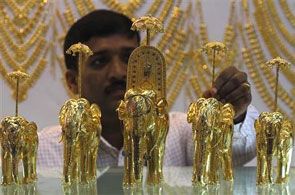 | « Back to article | Print this article |
Gold is a high-risk speculative bet at Rs 26,000-plus.
The April trade deficit statistics caused some panic. Crude imports of course, continue to be by far the largest import item. The second largest remains precious metals. Crude imports were up 4 per cent compared to April 2012, rising to $14.1 billion. Gold and silver (mainly gold) were up 138 per cent to $7.5 billion. Therefore, out of a total import bill of $42 billion, the combination of crude and precious metals contributed well over 50 per cent.
 These are very different types of goods. Crude is a necessary good. While there's plenty of speculative activity in crude, its difficult for an Indian individual to speculate in crude in any meaningful volume.
These are very different types of goods. Crude is a necessary good. While there's plenty of speculative activity in crude, its difficult for an Indian individual to speculate in crude in any meaningful volume.
Crude demand isn't very elastic with respect to price. Demand is also strongly correlated to economic activity. Crude prices in April 2012 were about 10 per cent higher than in April 2013. The rise in the April 2013 crude bill is due to higher imports in terms of quantity.
This is a positive signal. Higher crude consumption suggests economic activity is picking up. Incidentally, crude prices have softened in May 2013 as well, in comparison to April 2013. The gradual, long overdue rationalisation of diesel subsidy is also proceeding. So there are positive aspects to the oil import scenario.
Gold and silver are entirely different. Silver does have significant industrial usage in electronic applications, for example, but it is primarily an investment. Gold is almost entirely an investment asset, seen as a substitute for hard currency. These are not necessary goods.
Both metals, especially gold, have negative correlations to economic activity. People buy gold when they cannot see more productive ways to use cash - gold after all, earns no interest. Demand is driven by fear of inflation or currency weakness. There is also seasonal demand in India. Weddings and festivals like Akshay Tritiya absorb 500-600 tonnes a year in terms of demand. Indian imports have exceeded 850 tonnes per annum in the past three years – the excess over wedding demands is largely speculative.
Gold has dropped in price significantly in the past six months and there was a sharp drop in mid-April. Prices have continued to soften into May though jewellers are reportedly paying premiums to restock inventory.
There has been a surge in Indian demand as a result of lower prices and due to the Akshay Tritiya festival (May 13). January saw over 100 tonnes of gold imports. April also saw the 100 tonnes mark exceeded. Given fears of RBI putting curbs on banks importing gold, May could well cross the century mark. Incidentally Chinese imports have also shot up.
Investment assets like gold have interesting demand-price relationships. First, demand can often climb when price goes up and momentum traders chase the asset. Demand can also rise on a price dip if investors think the price correction is temporary. But if investors believe that the price has collapsed completely, demand can also evaporate. In the Indian context, physical demand will probably account for 600-650 tonnes anyhow. But the excess over that could disappear if there's a big bear market in gold.
Right now, investors believe that prices could climb back again and this is one reason why demand is strong in both India and China. Another reason is that Indian investors (and Chinese as well) have tended to lose money chasing financial assets in the past two or three years. Inflation has eroded the value of debt and few domestic investors have made money in the equity markets.
Ironically, the interest rate cycle has clearly changed and there is every reason to believe that equities and debt will give good returns over the next two years. Since May 2012, the RBI has cut the policy rate by 125 basis points. Despite its cautious public statements, the central bank is likely to continue cutting rates through FY 2013-14. That should boost returns for debt funds and it should also mean positive returns for equity. If growth picks up, so should earnings.
Gold is a high-risk speculative bet at Rs 26,000-plus. It could indeed bounce back above Rs 30,000 again as many enthusiasts expect. It could also fall further – and the downside could be much more. There is a global economic recovery, gold will fall. Prices are in fact, more likely to soften than to harden, given the trend through the past six months.
At the risk of repeating myself, if you buy gold at these prices, you must be prepared to set a loss limit and sell if there's a further catastrophic decline. Very few investors seem to see it as just another asset with specific characteristics, but that is all it is.